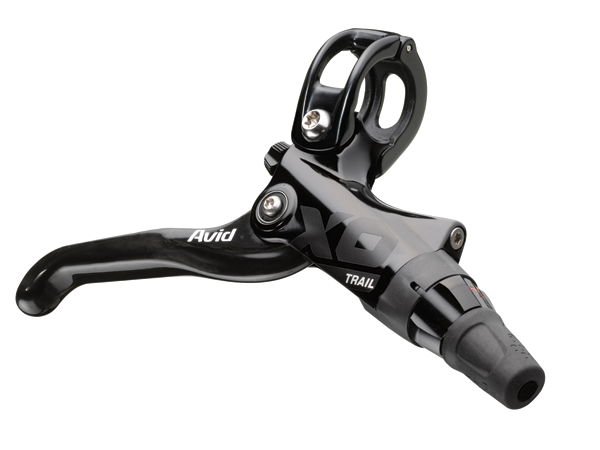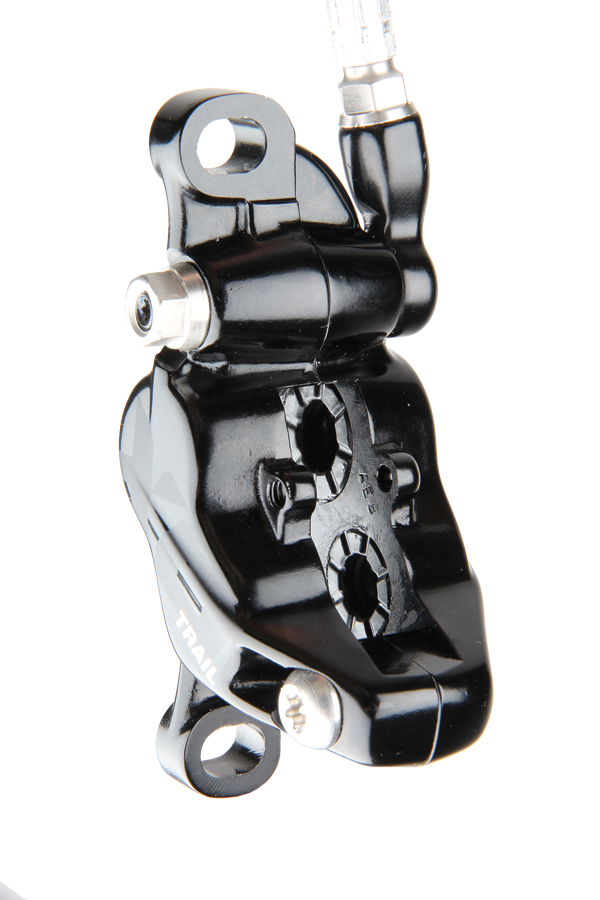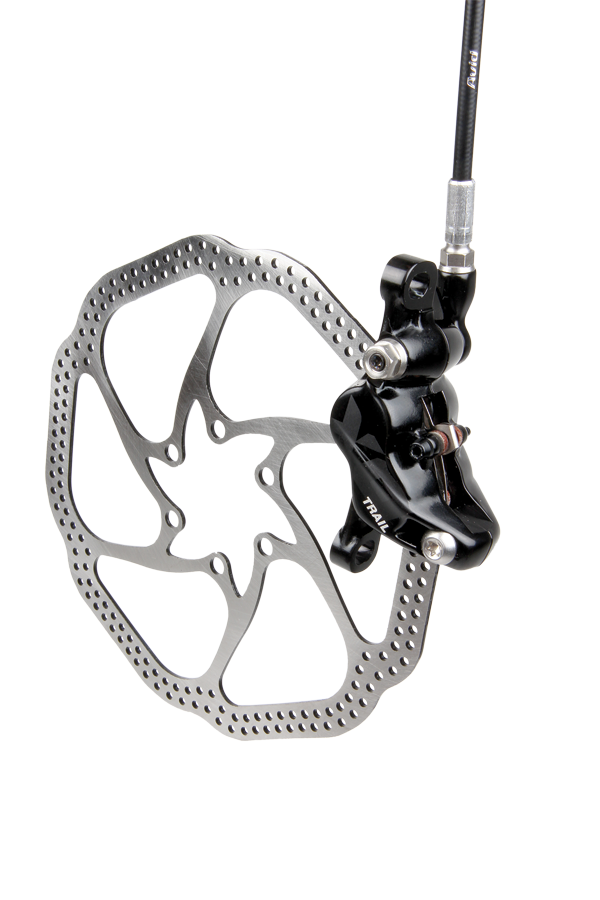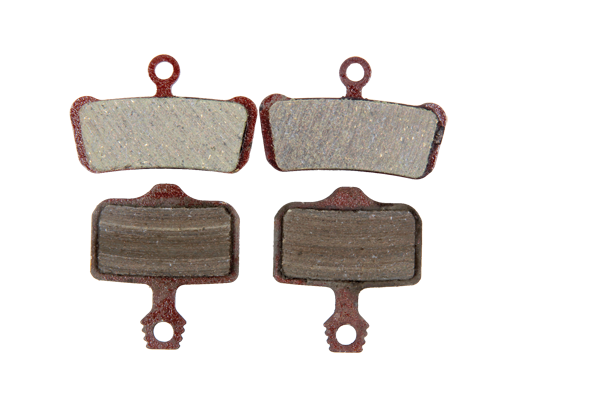Avid X.0 Trail Brakes
 ‘Trail’ seems to be the new industry catch phrase. It describes gear that’s more robust and functional than the weight weenie stuff but not full-on heavy like the downhill and freeride parts.
‘Trail’ seems to be the new industry catch phrase. It describes gear that’s more robust and functional than the weight weenie stuff but not full-on heavy like the downhill and freeride parts.
SRAM’s latest offering to the trail alter is the X.0 Trail brake; it retails for $320 per end with carbon lever blades. Most hydraulic discs utilise two pistons but this new brake features a downhill-inspired four-piston calliper along with an updated lever design. While it packs twice as many pistons, Avid has done well at slimming down the weight. With a carbon lever the front calliper, hose and master cylinder was 220g—that’s 20g lighter than Shimano’s XTR Trail brakes and only a handful of grams more than the twin-piston X.0 model. Factor in some mounting hardware plus a 160mm rotor and the system weight is just over 330g.
In addition to the trimmed-back calliper externals, the pistons have also been reduced in size when compared to Avid’s DH-specific Code brakes. Where Code callipers run 15 and 16mm pistons, X.0 Trail has a 14/16mm combination. Four smaller pistons don’t by default produce more power than a larger twin piston design. The real benefit comes from the longer pads used in the four-piston callipers. Measuring 14mm wide and 32mm long, the X.0 pads provide 20% more contact area than regular Elixir pads and they are bigger than most twin-piston pads currently on the market. Bigger pads mean more friction material, less heat build-up and potentially smoother power application. Sounds promising!
The new Trail lever is also different to the garden variety Elixir. On the outside it looks like their regular XC oriented levers but the main pivot uses a pair of sealed bearings; it’s not unlike their top-end Code gravity brakes and it gives the lever a really nice feel. Like all of their newer Avid models, they also employ an updated bleed port arrangement to make servicing a little less hit-and-miss. As with previous editions of the X.0 brake you get a very natural lever feel as well as tool-free reach and contact point adjustments.

SRAM claims the X.0 Trail offers more power than Shimano’s XTR Trail brake. That’s a bold claim as Shimano’s brakes have gained an enviable reputation for their power and control. I’ve spent plenty of time on the Shimano product, so I was certainly interested to see how they compared. From the outset it was clear that the new four-piston Avids have loads of power, and that was before they’d bedded-in completely. By the time the pads are fully run in, the X.0 Trail brakes totally eclipse their regular Elixirs and as claimed, they also surpass the power offered by current Shimano brakes. You’ll only ever need one finger with these brakes and the lever effort is very minimal, which is great for long and demanding descents.
Loads of power is worthless if it just locks the wheel in an uncontrolled manner. X.0 Trail delivers on this front too, with a really smooth ramp-up that lets you hold that edge between traction and losing it. At first the power of these binders may have you locking up a little more than you’d like but they are very easy to control once you’ve rewired your brain to suit.
Silky Silence – Mostly
In contrast to the Avids of old, smooth power delivery and silent stopping are the two things that I appreciated the most with these brakes. There were no turkey gobbles or chirps and even when riding in the wet they didn’t make a peep. I’ve had more noise from my Shimanos, especially in the wet where they seem more prone to contamination and power loss than the Avids. The four-piston calliper also offers plenty of pad retraction, so there was never any problem with rotor scrub.

After three months of use, I was totally sold on these brakes and got another set for my secondary bike. While they still had loads of power, my next set was not silent. Heavy braking was fine but light feathering would emit a high pitch ‘twitter’, and it happened with both the front and rear callipers. It wasn’t a full-on turkey gobble but it wasn’t total silence either.
I swapped these brakes across to my main bike thinking it could be due to poorly aligned mounts but the noise remained. I then fitted the rotors from the otherwise silent brakes but the noise persisted. Next I fitted all-new pads and rotors, carefully following the bedding-in process as per the instructions but the noise remained, this time morphing into a full on ‘gobble’ at times under hard braking. I also noticed that the noise was less prominent with a 160mm rotor—bigger rotors tended to make more noise. In the end I silenced them by using ‘CRC Disc Brake Quiet’ on the backing plates ($10 at your local auto spares store). Smeared on the back of the pads, this compound seemed to damp the vibration, but I remain perplexed as to why one pair of brakes needed this treatment and others did not. Sure, it’s only a noise but it was still off-putting and not what you want from a top-end brake.

My first set of X.0 Trail brakes was trouble-free, silent and ultra-powerful—they were probably the best stoppers that I’ve used from any brand. With Disc Brake Quiet on the backing plates, my second set were also great and I know of three other people running these brakes who haven’t experienced and any noise relates issues. Overall, the new four-piston calliper and longer pads seem to have produced a smoother and more consistent performing brake. When they are working as intended, they are by far the best XC/trail brake that Avid has made and one of the best brakes on the market.
Monza Imports (03) 8327 8080 / www.sram.com





